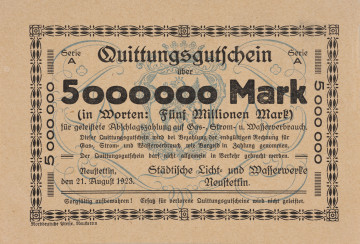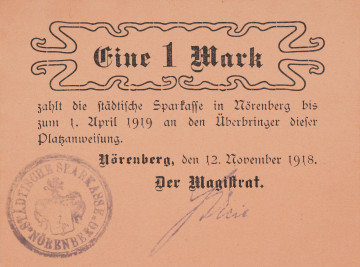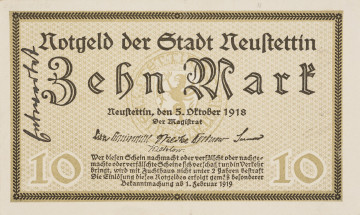
5 million marks
1923
National Museum in Szczecin
Part of the collection: Paper money
Difficulties in supplying raw materials to German troops during World War I resulted in the withdrawal of coins made of strategically important metals from circulation. Bronze, cupro-nickel, and nickel coins disappeared from the market, and earlier also silver half-marks. There was a shortage of low-denomination pfennigs, as well as 20- and 25-pfennig coins minted in minimal quantities. Citizens collected iron coins worth 5 and 10 pfennigs, which the Reichsbank used to unsuccessfully try to fill the gap in the availability of small means of payment. The lack of coins caused difficulties in retail trade. Merchants who were unable to give change to customers began to produce their own money in pfennig values, and the magistrates followed suit. Issuances of substitute means of payment were arbitrary and treated with distrust by the authorities, but tolerated due to the circumstances. They were first issued in 1914, and from 1916 they were issued regularly. Increasing inflation since 1918 slowly eliminated them from circulation, reducing them to a collector's piece in the early 1920s. The presented 50 Barwice pfennigs have the character of early replacement money, called small change – Kleingeldscheine, with the most simplified graphics. The name of the issuer and the denomination were printed on a small piece of cardboard. The serial number of the bill, handwritten at the bottom, was intended to suggest a supervised issue, similarly to a facsimile of the issuer's signature or the round municipal seal on the back. The Barwice city council issued such replacement money in the years 1917–1921 on white, light brown, and blue cardboard. The presented copy belongs to the last and most common issue of Barwice Notgelds, published with collectors in mind and only referring to editions from the period of World War I. It has no date of issue, but is believed to have been made in 1921. Mieszko Pawłowski
Other names
Notgeld, Gutschein, 50 Pfennig
Object type
voucher
Technique
flat printing
Material
cardboard
Origin / acquisition method
purchase
Creation time / dating
Creation / finding place
Owner
Muzeum Narodowe w Szczecinie
Identification number
Location / status

1923
National Museum in Szczecin

1918
National Museum in Szczecin

1918
National Museum in Szczecin
DISCOVER this TOPIC
Castle Museum in Łańcut
DISCOVER this PATH
Educational path